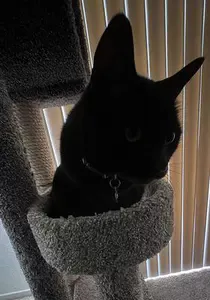How to introduce a stray cat into the house with another cat?
by Anonymous
Anyone with experience introducing a stray cat into the house with another cat?
I brought in an abandoned cat about four weeks ago and my inside cat went crazy.
She hid in the basement for several days and I was finally able to get her into my bedroom with litter, food and water.
She seems so afraid and depressed because her world has suddenly gotten smaller. Meanwhile, the new kitty who I de-flead, and took to the vet for shots, has the run of the house.
She's not aggressive at all and pays little attention to my cat, but I feel bad and don't know what to do.
I have a gate up in the hallway so my cat is safe in the bedroom, but I would like her to get up enough braveness to venture out and see that all is well and the new kitty is no threat.
I have done the smell things with the food and toys, but doesn't seem to have helped. Will it just take time, or is there more I should do? Help!!!
Editor's note: Thank you for taking in a stray cat! Introductions can be tricky. I know you said that you've done the "smell things" but there's often a bit more to it than that.
I'm not sure what else you've done and it's a process that starts by satisfying your existing cat's need to own the territory.
So, I'm going to run through this so that others who read this will get the full picture and we'll help you in the process.
Since your existing cat is having issues with the new cat being there, I suggest you roll back the clock and confine the new cat to a room (but not your bedroom), and follow the process outlined below.
The thing is, it doesn't matter how non-threatening the new cat seems to be. What matters is how your existing cat perceives the situation and how the introduction is done.
Right now, your existing cat is feeling like the outsider. We need to get her back to feeling confident and top cat.
Ready? Here we go...
The very first thing you do when you bring a new cat into the house (other than take it to the vet) is you set up a safe room.
This is where you quarantine the new cat. Set up a cat proof room with all of the amenities:
1) Preferably a sunny room.
2) Toys to play with.
3) A bed to sleep in.
4) A litter box.
5) A food and water bowl.
What you've described here in your house is the opposite. Your existing cat is in quarantine, and the newcomer is the king of the house. It should be the other way around.
There are several reasons why we quarantine the new cat. They include:
1) To establish a routine and get the new cat used to the home, including litter box habits for the new cat.
2) To monitor for signs of disease and prevent disease transmission to the existing cat.
3) To prevent confrontation and allow for a less threatening and controlled way to introduce the new cat to your existing cat.
Introductions need to be done slowly, and your existing cat will feel less threatened if everything remains the same except for that small space in the house that the newcomer has been given.
No one would like it if their new roommate moved in and took over the house. Your cat likes it even less and was not even given the choice of saying no to the newcomer!
Confining the new cat also reduces the chance that the new cat will bring in a disease or parasites and infect the existing resident cat.
Cats that come from shelters may have upper respiratory infections and they may not start showing symptoms until they've been in your house for a couple of days. It's better to be safe than sorry.
The new cat will be able to get used to the new home in relative safety and not have to battle head-to-head for territory with a resident cat.
Some people will use a cage for the quarantine period. Others will simply confine the new cat to a room, much as you have done with your existing cat. A towel stuffed under the door is often enough to prevent actual contact and fighting.
The initial quarantine takes place with no contact between the two animals. This is done for safety and prevention of disease. After a period of days, depending upon the
But, the new cat remains confined to the safe room. Then, the introductions start.
The first introduction is not really an introduction at all. We allow the cats to smell each other while they remain separated.
How? By "scent swapping" using a towel or rag with the new cat's scent on it. Take a clean rag and wipe the new cat down with it. Then, wipe your existing cat with the same rag.
Then go back to the new cat and wipe again. Keep doing this back and forth several times a day for several days. I also recommending getting both cats to sleep on blankets or cat beds, and swapping the blankets or beds back and forth as well as toys.
This begins to develop what's sometimes called the communal scent and helps to grease the wheels, so to speak. If the cats smell like each other, it's much easier when they come face-to-face.
I'm guessing that's what you mean by the "smell things."
You can also sometimes tell how a resident cat will take to a new cat by taking the new cat's toy with the scent on it and giving it to the resident cat. If the resident cat acts relaxed, that may be a good sign.
Territory swap
Next we graduate to territory swapping. Your resident cat gets moved into the safe room and is confined there. Your new cat gets moved out to the rest of the house (or a small section of the rest of the house).
Both cats will instinctively begin to scent up the area, moving the environment more towards that communal scent. Swap the cats back and forth several times and let them scent the place up.
Play sessions
Next, with everyone back in their respective areas, remove the towel from under the door and encourage "under the door" play. A wand or fishing pole type toy can be good for this. A pleasurable activity such as play with both cats near each other greases the wheels some more.
Feed them at the same time
At feeding time, place your resident cat's feeding bowl right outside the door to the room, and your new cat's bowl on the other side of the door so that both cats can engage in eating near each other. You can do this with treat time as well.
Rinse and repeat
Keep repeating these play and feeding sessions for a while and what will typically happen is that one of the cats will begin to reach out to the other under the door.
They may play. They may hiss and growl, it just depends.
This introduction period can last anywhere from several days to several weeks, depending upon the personalities of the cats involved. Normally, there will be more play and less hiss over time.
Side-by-side meeting
At some point, it's time to put them together in a room and see how they do. Side-by-side (not face-to-face) feedings are good for this to keep them distracted.
Throughout the process, both cats need attention and playtime, and your existing cat needs to be reassured through extra attention.
In your situation, this slow introduction process has been short circuited and your resident cat has become fearful and feels threatened. You need to provide an environment for her where she can take back her territory. It starts with confining the new cat and going through the introduction process.
In a nutshell:
Quarantine the new cat.
After the initial quarantine period (most people I've talked to will do 3 to 10 days), the cats remain separated, but it's time to start "scent swapping."
Next, start territory swapping.
Next, start doing pleasurable activities with both cats on either side of the door. Do under the door "play and greet" and mutual feeding/treat time.
Keep repeating the scent swapping, territory swapping and fun time activities.
If you have a sliding glass door, an interesting test is to put them on opposite sides of the door and see how they react when they can see each other in full view. Try feeding them like that as well.
When there's less obvious aggressive behavior, start putting the cats together. Use your judgement, and supervise them together. After there has been peace and both cats are acting normally, you can integrate them full time.
I hope that helps. Please leave us a comment and let us know how they're getting along as time goes on.
-Kurt
Comments for How to introduce a stray cat into the house with another cat?
|
||
|
||
|
||
|
||
|
||
|
||
|
||
|
||
|
||
|
||
|
||

